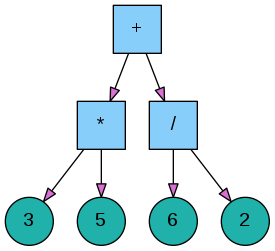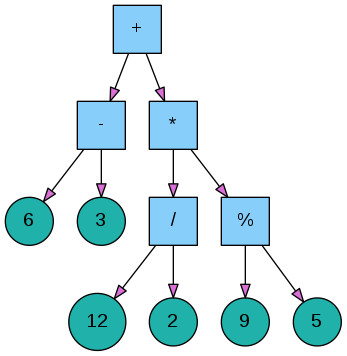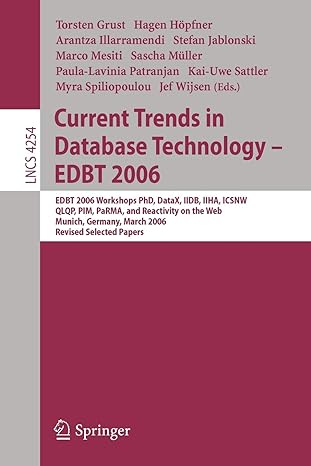Question
Expression Trees JAVA DO NOT CHANGE ANY CODE ONLY MODIFY CODE IN SPECIFIED METHODS Objectives Learn how to parse an infix expression into a list
Expression Trees JAVA
DO NOT CHANGE ANY CODE ONLY MODIFY CODE IN SPECIFIED METHODS
Objectives
Learn how to parse an infix expression into a list of tokens.
Convert a list of tokens from infix to postfix.
Build a tree data structure to represent the expression.
Traverse the tree in prefix, infix, and postfix order.
Use the tree to evaluate the expression.
In the ExpressionTree class, implement the following methods (or their corresponding helper methods):
parse method
convert method
build method
prefix method
infix method
postfix method
evaluate method
The TestCode class is provided for testing, and is similar to the code used for automated grading. It takes one command line parameter, which is the expression. You must place the expression in double quotes, for example "3*5+6/2" or "5-3+12/2*(9%5)". The test code calls all of the abstract methods in main. If you want, you can comment out or ignore methods that you have not yet implemented, to allow for incremental development. Here is an example output for the two expressions above:
For the expression "3*5+6/2":
Original Expression: 3*5+6/2 Infix Tokens: [3, *, 5, +, 6, /, 2] Postfix Tokens: [3, 5, *, 6, 2, /, +] Build: complete Prefix: + * 3 5 / 6 2 Infix: ((3*5)+(6/2)) Postfix: 3 5 * 6 2 / + Evaluate: 18 Display: complete
And here is the resulting expression tree:

For the expression "6 - 3 + 12 / 2 * (9 % 5)":
Original Expression: 6 - 3 + 12 / 2 * (9 % 5) Infix Tokens: [6, -, 3, +, 12, /, 2, *, (, 9, %, 5, )] Postfix Tokens: [6, 3, -, 12, 2, /, 9, 5, %, *, +] Build: complete Prefix: + - 6 3 * / 12 2 % 9 5 Infix: ((6-3)+((12/2)*(9%5))) Postfix: 6 3 - 12 2 / 9 5 % * + Evaluate: 27 Display: complete
And here is the resulting expression tree:

// ATree.java - abstract class for expression tree assignment. // Author: Chris Wilcox // Date: 3/19/2017 // Class: CS165 // Email: wilcox@cs.colostate.edu
import java.nio.charset.MalformedInputException; import java.util.ArrayList; import java.util.Deque; import java.util.List; import java.util.Queue;
/** * Provides the Node data structure and defines the abstract methods * that you need to implement in ExpressionTree.java. It also has a * method that converts an expression tree into a format that can be * displayed graphically. * * @author Chris Wilcox * Date: 3/19/2017 * Class: CS165 * Email: wilcox@cs.colostate.edu */ public abstract class ATree {
/** * */ public Node root;
/** * */ public class Node {
/** * */ public String token; /** * */ public Node left; /** * */ public Node right;
/** * * @param value */ public Node(String value) { this.token = value; } }
/** * Parse an infix expression into an {@link ArrayList} of tokens. *
* Reads a string that contains an infix expression, and converts * it to a list of tokens. Each token is an operator, operand (integer), or * parentheses. We suggest using the StringTokenizer method of lexing from the * expressions lab, no changes should be necessary except for the addition of the * modulo operator. The parse method should be able to handle an arbitrary number * of white spaces in the expression. Our implementation of this method is ~8 lines * of code, including brackets but not comments or white space. * @param expression a valid expression * @return expression in infix order */ public abstract Queue
/** * Convert an infix expression into postfix order. *
* Converts the list of tokens from the parse method from infix to postfix, * using the Shunting-yard algorithm from Edsger Dijkstra, a famous computer * scientist, as documented here. * Our implementation uses {@link Queue} for the queue, and {@link Deque} * for the stack. You may want to use the utility methods {@link #isOperator(String)}, * {@link #isInteger(String)}, and {@link #precedence(String)}. *
* Our implementation is ~21 lines of code. * @param infix expression in infix order * @return expression in postfix order */ public abstract List
/** * Calls a recursive helper method to build an expression tree from a postfix {@link List}. * @param postfix the expression tree */ public abstract void build(List
/** * Calls a recursive helper method to traverse the expression tree in prefix order and build expression. * @return a string representing the expression in prefix order. */ public abstract String prefix();
/** * Calls a recursive helper method to traverse the expression tree in infix order and build the expression. * @return a string representing the expression infix order. */ public abstract String infix();
/** * Calls a recursive helper method to traverse the expression tree in postfix order and build the expression. * @return a string representing the expression in postfix order. */ public abstract String postfix();
/** * Calls a recursive helper method to evaluate expression tree and return the result. * @return the result of the expression. */ public abstract int evaluate();
/** * Displays the expression tree in graphical format. * @return a dot file representation of the tree. */ public ArrayList
ArrayList
/** * * @param current * @param graph * @param name */ public void displayRecursive(Node current, ArrayList
// // Utility methods //
/** * @param token a token * @return true if token is an operator. */ public static boolean isOperator(String token) { switch (token) { case "*": case "/": case "%": case "+": case "-": return true; default: return false; } }
/** * @param token a token * @return true if the token is an int. */ public static boolean isInteger(String token) { try { Integer.parseInt(token); return true; } catch (NumberFormatException e) { return false; } }
/** * Converts an {@code String} into an {@code int}. * For example the string "11" is converted to the int 11. * @param token a string representing a number * @return the decimal representation if the token or -1. */ public static int valueOf(String token) { try { return(Integer.parseInt(token)); } catch (NumberFormatException e) { return -1; } }
/** * Returns operator precedence. * @param operator the operator to evaluate * @return a ranking of operator precedence. */ public static int precedence(String operator) { switch (operator) { case "+": case "-": return 2; case "*": case "/": case "%": return 1; default: return 0; } } }
-------------------------------------------------------------------------------------
import java.nio.charset.MalformedInputException; import java.util.*;
/** * */ public class ExpressionTree extends ATree {
public Queue
public List
@Override public void build(List
/** * Builds an expression tree from the postfix representation returned from the convert method. * To build the correct tree, pull tokens from {@code List *
* * Our implementation of the recursive method is ~19 lines of code * @param current the current Node being checked * @param token the token to add * @return {@code true}, if successful */ public boolean buildRecursive(Node current, String token) { // YOUR CODE HERE
return false; }
@Override public String prefix() { return prefixRecursive(root); }
/** * Concatenates the tokens in the expression tree returned from the * {@link #build(List)} method in prefix order. *
* Accumulate the operator first, then the string from the left * and right subtrees. Add an extra space after each token. *
* Our implementation of this method is ~2 lines of code. * @param current the root node * @return the tokens in prefix order */ public String prefixRecursive(Node current) { // YOUR CODE HERE
return ""; }
@Override public String infix() { return infixRecursive(root); }
/** * Concatenates the tokens in the expression tree returned from the * {@link #build(List)} method in infix order. *
- *
- Accumulate the string from the left subtree *
- Add the operator *
- Accumulate the string from the right subtree *
* Our implementation of this method is ~2 lines of code. * @param current * @return the tokens in infix order */ public String infixRecursive(Node current) { // YOUR CODE HERE
return ""; }
@Override public String postfix() { return postfixRecursive(root); }
/** * Concatenates the tokens in the expression tree returned from the * {@link #build(List)} method in postfix order. * First accumulate the string from the left and right subtrees, then add the * operator. Add an extra space after each token. *
* Our implementation of this method is ~2 lines of code. * @param current * @return */ public String postfixRecursive(Node current) { // YOUR CODE HERE
return ""; }
public int evaluate() { return evaluateRecursive(root); }
/** * Traverses the expression tree and produces the correct answer, which should be an integer. * To evaluate, call the recursive version of the method to get the result from the left * subtree, do the same for the right subtree, then combine these two results using the * operator. A case statement based on the operator is needed to perform the arithmetic. *
* Our implementation uses one helper method (~7 lines of code) and is, itself, ~2 lines of code. * @param current * @return */ public int evaluateRecursive(Node current) { // YOUR CODE HERE
return -1; }
}
--------------------------------------------------------------------------
// TestCode.java - test code for expression tree assignment. // Author: Chris Wilcox // Date: 3/19/2017 // Class: CS165 // Email: wilcox@cs.colostate.edu
import java.io.File; import java.io.IOException; import java.io.PrintWriter; import java.nio.charset.MalformedInputException; import java.util.*;
public class TestCode {
// Test code for public static void main(String[] args) throws MalformedInputException{
// Instantiate student code ExpressionTree eTree = new ExpressionTree();
String expression = args[0]; System.out.println("Original Expression: " + expression);
// Verify parse Queue
// Verify convert List
// Verify build eTree.build(postfix); System.out.println("Build: complete");
// Verify prefix System.out.println("Prefix: " + eTree.prefix());
// Verify infix System.out.println("Infix: " + eTree.infix());
// Verify postfix System.out.println("Postfix: " + eTree.postfix());
// Verify evaluate System.out.println("Evaluate: " + eTree.evaluate());
// Verify display System.out.println("Display: complete"); ArrayList
// Utility method to write contents of ArrayList to file public static void writeFile(String filename, ArrayList
Step by Step Solution
There are 3 Steps involved in it
Step: 1

Get Instant Access to Expert-Tailored Solutions
See step-by-step solutions with expert insights and AI powered tools for academic success
Step: 2

Step: 3

Ace Your Homework with AI
Get the answers you need in no time with our AI-driven, step-by-step assistance
Get Started


